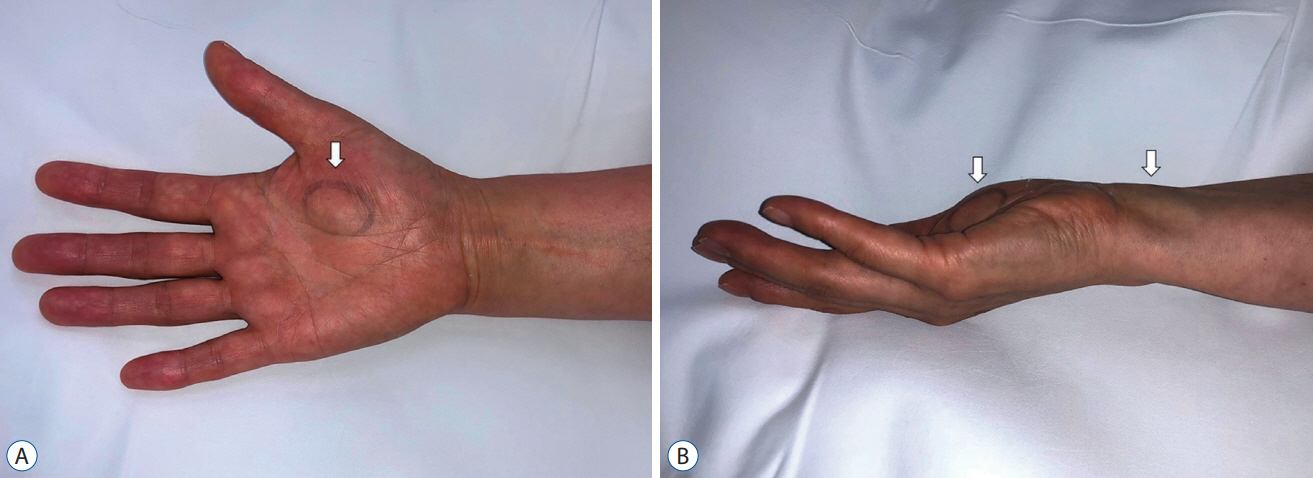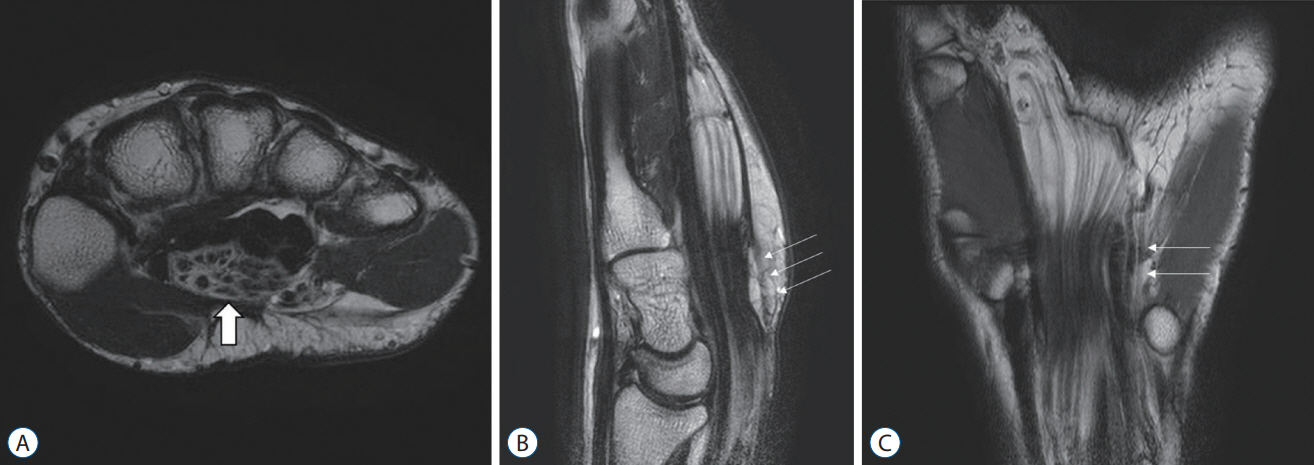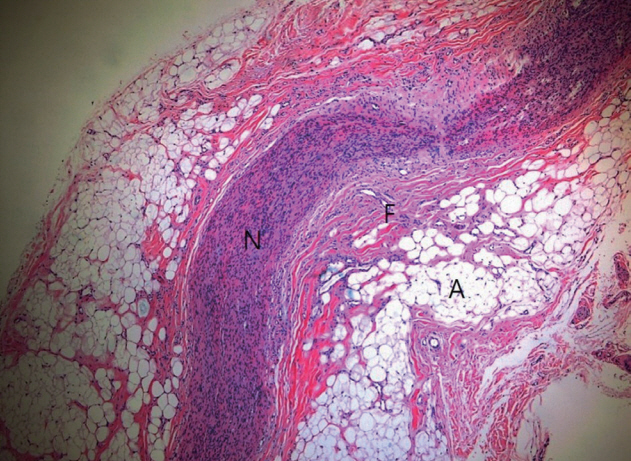J Korean Neurosurg Soc.
2020 Sep;63(5):664-670. 10.3340/jkns.2020.0082.
Carpal Tunnel Syndrome Caused by Lipofibromatous Hamartoma of the Median Nerve
- Affiliations
-
- 1Department of Orthopaedic Surgery, 1 H Plus Yangji Hospital, Seoul, Korea
- 2Department of Orthopaedic Surgery, 2 Yeouido St. Mary’s Hospital, College of Medicine, The Catholic University of Korea, Seoul, Korea
- 3Department of Orthopaedic Surgery, 3 Bucheon St. Mary’s Hospital, College of Medicine, The Catholic University of Korea, Seoul, Korea
- KMID: 2506031
- DOI: http://doi.org/10.3340/jkns.2020.0082
Abstract
- Lipofibromatous hamartoma (LFH) is a rare tumor of the peripheral nerves, which usually involves the median nerve. The authors reported on two rare cases of carpal tunnel syndrome due to LFH of the median nerve. A 49-year-old female patient complained of the mass and symptoms consistent with LFH. Magnetic resonance imaging (MRI) showed typical LFH findings. The symptoms were successfully ameliorated with carpal tunnel release and external neurolysis. A 37-year-old female patient complained of weakening thumb abduction and the mass where the MRI showed atypical findings. Opponensplasty and debulking operations were performed after which thumb abduction was improved; however, neurological sequelae remained. LFH of the median nerve is managed on a case-by-case basis as treatment guidelines are not very clearly defined yet. However, the less invasive treatment such as carpal tunnel release and external neurolysis than more aggressive surgical treatment should be recommended as a treatment option.
Figure
Reference
-
References
1. Afshar A. Carpal tunnel syndrome due to lipofibromatous hamartoma of the median nerve. Arch Iran Med. 13:45–47. 2010.2. Agarwal S, Haase SC. Lipofibromatous hamartoma of the median nerve. J Hand Surg Am. 38:392–397. quiz 397. 2013.
Article3. Agrawal R, Garg C, Agarwal A, Kumar P. Lipofibromatous hamartoma of the digital branches of the median nerve presenting as carpal tunnel syndrome: a rare case report with review of the literature. Indian J Pathol Microbiol. 59:96–98. 2016.4. Al-Jabri T, Garg S, Mani GV. Lipofibromatous hamartoma of the median nerve. J Orthop Surg Res. 5:71. 2010.
Article5. Clavijo-Alvarez JA, Price M, Stofman GM. Preserved neurologic function following intraneural fascicular dissection and nerve graft for digital and median nerve lipofibromatous hamartoma. Plast Reconstr Surg. 125:120e–122e. 2010.
Article6. Hoellwarth JS, Goitz RJ. Lipofibromatous hamartoma of the palmar cutaneous branch of the median nerve. J Hand Microsurg. 10:109–112. 2018.
Article7. Kitridis D, Dionellis P, Xarchas K, Givissis P. Giant median nerve due to hamartoma causing severe carpal tunnel syndrome. J Orthop Case Rep. 8:57–60. 2018.8. Mason ML. Proceedings of the American Society for Surgery of the Hand: presentation of cases. J Bone Joint Surg Am. 35:273–275. 1953.9. Mohammed Saeed MA, Dawood AA, Mahmood HM. Lipofibromatous hamartoma of the median nerve with macrodactyly of middle finger. J Clin Orthop Trauma. 10:1077–1081. 2019.
Article10. Nardella D, Sohawon S, Carlier A. Lipofibromatous hamartoma of the median nerve. Three case reports. J Plast Reconstr Aesthet Surg. 62:e314–e317. 2009.
Article11. Razzaghi A, Anastakis DJ. Lipofibromatous hamartoma: review of early diagnosis and treatment. Can J Surg. 48:394–399. 2005.12. Silverman TA, Enzinger FM. Fibrolipomatous hamartoma of nerve. A clinicopathologic analysis of 26 cases. Am J Surg Pathol. 9:7–14. 1985.13. Tahiri Y, Xu L, Kanevsky J, Luc M. Lipofibromatous hamartoma of the median nerve: a comprehensive review and systematic approach to evaluation, diagnosis, and treatment. J Hand Surg Am. 38:2055–2067. 2013.
Article14. Toms AP, Anastakis D, Bleakney RR, Marshall TJ. Lipofibromatous hamartoma of the upper extremity: a review of the radiologic findings for 15 patients. AJR Am J Roentgenol. 186:805–811. 2006.
Article15. Ulrich D, Ulrich F, Schroeder M, Pallua N. Lipofibromatous hamartoma of the median nerve in patients with macrodactyly: diagnosis and treatment of a rare disease causing carpal tunnel syndrome. Arch Orthop Trauma Surg. 129:1219–1224. 2009.
Article
- Full Text Links
- Actions
-
Cited
- CITED
-
- Close
- Share
- Similar articles
-
- Recurrent Lipofibromatous Hamartoma of the Median Nerve
- Lipofibromatous Hamartoma of Median Nerve with Carpal Tunnel Syndrome: A Case Report
- Lipofibromatous Hamartoma on the Median nerve: A Case Report
- The Change of Preoperative and Postoperaive Magnetic Resonance Imaging Findings in Lipofibromatous Hamartoma of the Median Nerve
- Carpal Tunnel Syndrome Caused by Persistent Median Artery and Bifid Median Nerve in an Adolescent







